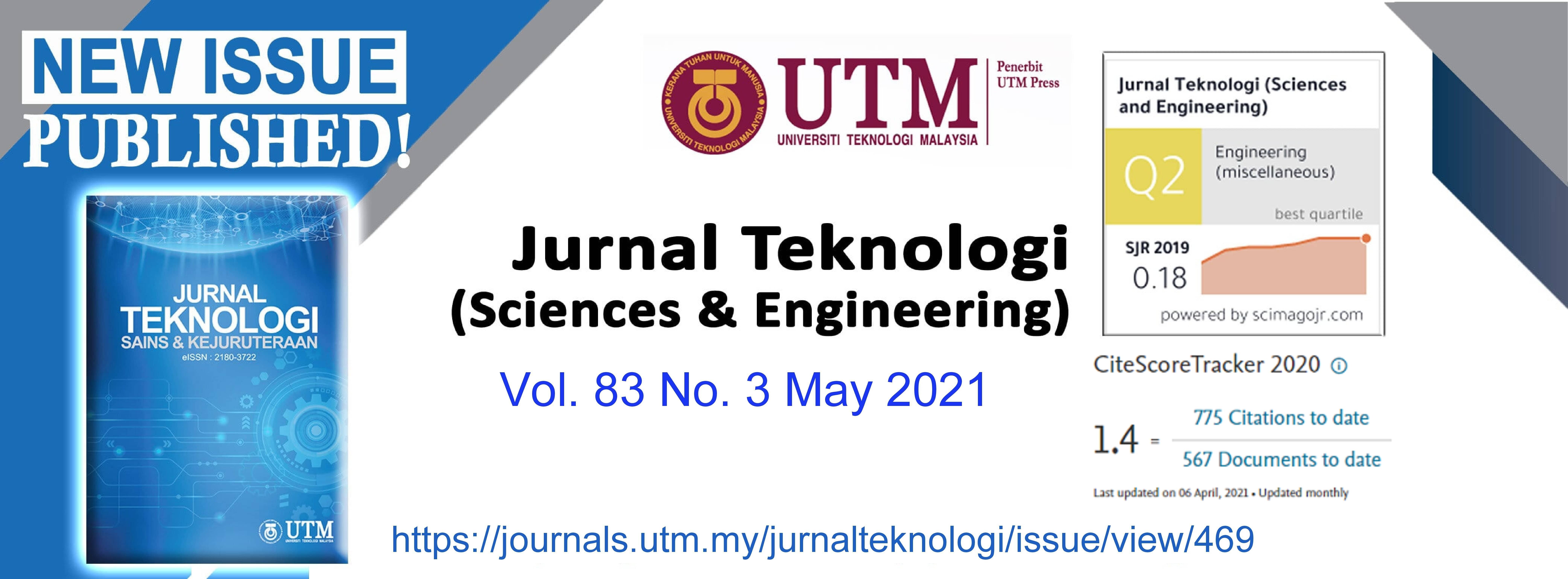THE SIMULATION OF MECHANICAL STIMULATION EFFECT ON BONE ELASTICITY LIMIT BASED ON FINITE ELEMENT METHOD (FEM)
DOI:
https://doi.org/10.11113/jurnalteknologi.v83.14479Keywords:
Bone remodelling, bone density, elasticity limit, finite element method, mechanical stimulationAbstract
Osteoporosis is a disease affecting bones which is characterized by decreased bone density; bones become porous and susceptible to fractures. Osteoporosis occurs because of an imbalance during bone remodeling phase between resorption and formation processes. This study aims to simulate the effects of mechanical stimulations on the femoral bone elasticity limit. It is hoped that these mechanical stimuli can provide information on bone elasticity limits. Initially, we constructed the femur in two layers using triangular elements. Then we entered the bone properties (Young’s modulus and Poisson’s ratio) based on the age of the femur. After that we calculated the value of the stress, strain, and strain rate in the reversal phase. Next, we calculated the bone density using the thermodynamic equation and calculation of the bone elasticity limit using particle swarm optimization (PSO) methods. The value of stress and strain caused by walking is higher than the value of stress and strain when standing still. In this case, the difference in activity results an increase in stress by 33.82% and an increase in strain and strain rate by 34.57%. Based on these simulation results, it can be concluded that mechanical stimulation can increase the limit of bone elasticity to 2.99% in cortical bone and 0.975% in trabecular bone. Bone elasticity limit can be used to determine the level of osteoporosis that occurs. The higher value of the bone elasticity, the smaller the possibility of osteoporosis.
References
Kemenkes RI. 2015. Pusat Data dan Informasi Kementrian Kesehatan RI : Data & Kondisi Penyakit Osteoporosis di Indonesia. Jakarta Selatan: Kementrian Kesehatan RI.
Corwin, Elizabeth. 2009. Book I Patofisiologi. Jakarta: EGC.
Tandra, Hans. 2009. Osteoporosis: Mengenal, Mengatasi dan Mencegah Tulang Keropos. Jakrta: Pt. Gramedia Pustaka Utama.
Sihombing, Iknes, Sunny Wangko & Sonny J.R. Kalangi. 2012. Peran Estrogen pada Remodeling Tulang. Jurnal Biomedik. Vol.4. No.3.
Usha, Kini & B.N. Nandeesh. 2012. Physiology of Bone Formation, Remodeling and Metabolism. India : Springer- Verlag Berlin Heidelberg.
Nogues, X. & D. Martinez Laguna. 2018. Update on Osteoporosis Treatment. Med Clin (Barc). 150 (12): p. 479-486.
Cerrolaza, Miguel, Vannessa Duarte, Diego Garzón-Alvarado. 2017. Analysis of Bone Remodeling Under Piezoelectricity Effects Using Boundary Elements. Journal of Bionic Engineering. Vol.14 No.4. DOI:10.1016/S1672-6529(16)60432-8
Klika V & Marsik F. 2006. Mathematical and numerical analysis of differential equations of bone remodelling. Czech technical university Faculty of nuclear science and physical Engineering Department of mathematics (CZ).
Klika V & Marsik F. 2010. A thermodynamic model of bone remodelling: the influence of dynamic loading together with biochemical control. J Muscul Neur Inter. 10(3):220-230. DOI: 10.1016/J.medcli.2017.10.019
Idhammad, A., Abdali A, Alaa N. 2013. Computational simulation of the bone Remodeling using the finite element method: an elastic-damage theory for small displacements. Theor Biol Med Model. 10:32. DOI: 10.1186/1742-4682-10-32
Damien, PB., Kevin JM, Joseph FB. 2010. Anatomy & Biomechanics of the Hip. Op Sport Med J. 4: 51-57. DOI: 10.21.74/1874387001004010051
Nikishkov, G. P. 2004. Introduction in the Finite Element Method. Japan: University of Aizu.
Kwon, Young W, & Hyochoong Bang. 1996. The Finite Element Method Using Matlab. New York : CRC Press.
Keaveny, TM., Morgan EF, Oscar C. 2004. Bone mechanics. California (AS): McGraw-Hill.
Martini FH, Nath JL, Bartholomew EF. 2009. Fundamentals of Anatomy & Physiology 9th ed. San Francisco (AS). Publishing as Pearson Benjamin Cummings.
Davis, Lawrence. 2019. Body Physics : Motion to Metabolism. Jepang: Open Oregon Educational Resourches.
Rosa, Nataca, Richardo Simoes, Fernao D. Magalhaes & Antonio T. Marques. 2015. From Mechanical Stimulus to Bone Formation : A Review. Medical Engineering and Physics. 37 (8).http://dx.doi.org/10.1016/j.medengphy.2015.05.015
Yakin, Khusnul. 2018. Influence Of Mechanical Stimulation On Bone Tissue Elasticity With FEM. Jurnal Neutrino. Vol 11. No.1. https://doi.org/10.13057/ijap.v3i01.1236
Reddi, MVK, Ganesh BKC., Bharathi KCK., Chitti Babu P. 2016. Use of Finite Element Analysis to Predict Type of Bone Fractures & Fracture Risks in Femur due to Osteoporosis. J Osteopor Phys Act. 4:180. DOI: 10.4172/2329-9509.1000180
Rouhi, Gholamreza. 2012. Biomechanics of Osteoporosis: The Importance of Bone Resorption and Remodeling Processes. Osteoporosis. 60-72. DOI:10.5772/29987
Noor, I., Ahmad, F., Irzaman, and Alatas, H. (2017). Simulation of Heat Transfer in Husk Furnace with Cone Geometry Based on Conical Coordinate System. Journal of Physics: Conference Series, 877(1), 1-7.
Noor, I., Irzaman, Syafutra, H., and Ahmad, F. (2016). Simulation of Heat Transfer in Cylinder Husks Furnace with Finite Difference Method. IOP Conference Series: Earth and Environmental Science, 31(1), 1-6.
Abdurrahman et al., “Optimization and Interpretation of Heat Distribution in Sterilization Room Using Convection Pipe,†Indones. J. Sci. Technol., vol. 4, no. 2, pp. 204–219, 2019. 10.17509/ijost.v4i2.18177.
Downloads
Published
Issue
Section
License
Copyright of articles that appear in Jurnal Teknologi belongs exclusively to Penerbit Universiti Teknologi Malaysia (Penerbit UTM Press). This copyright covers the rights to reproduce the article, including reprints, electronic reproductions, or any other reproductions of similar nature.
















